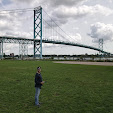The opening of the Frisco Bridge in 1892 transformed Memphis
into a national railroad hub and within only a few years of its completion, the
railroad infrastructure of the area (as well as the bridge itself) had become
dated and inadequate to serve the large increase in cross-river traffic demand
both locally and regionally. The solution was the construction of a parallel bridge
at the same location that would address the rising demands of the railroad
industry, while being forward-looking in how it would handle new-age modes of
transportation. This bridge, the Harahan Bridge, was completed in 1916 and was
the second bridge completed across the lower Mississippi River at Memphis.
City of Memphis officials (including then-Mayor E.H. Crump) reached an agreement on the scope of the new project with the Rock Island Railroad in 1912 and construction began the following year. Like the Frisco Bridge next door, the Harahan Bridge was a major design achievement for another prominent American civil engineer. Ralph Modjeski served as chief engineer for this project, one of his many influential bridge designs across the United States in the early 20th Century. His design called for a larger and wider bridge that carries two railroad tracks, instead of the single track design of the Frisco Bridge. The steady rise of the automobile as a reliable means of personal transportation at this time was on the mind of planners and engineers and this new travel mode was accounted for in the design of the new structure. A pair of roadways (or “wagonways” as they were known originally) are cantilevered outside the main steel superstructure, each 14 ft wide, enabling ample space for automobiles, pedestrians, and wagons in each direction. This configuration of the roadways in relation to the superstructure is a design that went on to be copied and mimicked with multiple other railroad bridges that were built on the lower Mississippi River in the ensuing decades.
The need to accommodate
ever-heavier railroad loads with a higher-capacity railroad deck meant that the
superstructure of this bridge had to be built much heavier with far more steel
than its predecessor next door. In this unique case, it’s possible to see how
much railroad bridge engineering evolved over a short period of time around the
turn of the 20th century, as the two primary examples of this progression stand
side-by-side at this location. At about one mile in length, the finished bridge
was very similar in proportion to its neighbor just downriver. The span lengths
were required to be kept the same so that the piers of both bridges would line
up in the river navigation channels and reduce the hazard to on-water traffic.
The Harahan Bridge carried its first train on July 14, 1916. The bridge was planned to be named “Rock Island Bridge” but was named instead for railroad executive James Theodore Harahan prior to its completion. Harahan was an influential railroad magnate with the Illinois Central Railroad who was killed in a railroad accident in January 1912. Ironically, he was en route to Memphis for further discussions with the city’s officials about the project that was then still only an idea, and he was a strong supporter of the project that bears his name today.
While the new bridge handled the demands of the railroad
industry adequately, the same could not be said in the long term for its innovative
wagonways, which became overworked with automobile traffic in the 1930s and
40s. This reality led to the planning and construction of a third bridge at
this location exclusively to accommodate the rise of the automobile as the
dominant mode of cross-river transportation in the years after World War II.
This third bridge, the Memphis & Arkansas Bridge, was completed in 1949 and
upon its opening, the wagonways on the Harahan Bridge were closed to all
traffic.
The former wagonways sat abandoned for the ensuing decades until the city of Memphis reached an agreement with the bridge’s principal owner the Union Pacific Railroad to restore the wagonway on the north side of the structure for pedestrian and bicycle traffic as part of an urban trail serving the Memphis area. The project was completed in time for the bridge’s centennial year in 2016 and the facility is known as the Big River Crossing, although the official name of the bridge remains the Harahan Bridge today. The walkway makes use of the original 1916 infrastructure as well as improvements made in the 1930s to the wagonway approach roads on the Arkansas landing and it offers sweeping views of the Memphis skyline to the north while giving pedestrians the unique experience of sharing a bridge with an active railroad corridor. The south wagonway has never been restored to any sort of function and it is likely that this will remain the case in the years to come.
Further Reading:
Harahan Bridge/"Big River Crossing" by John Weeks
Harahan Bridge/"Big River Crossing" at historicbridges.org
"Walking In Memphis", feat. the Big River Crossing by Gribblenation
Bridges, Crossings, and Structures of the Lower Mississippi River
Next Crossing upriver: Hernando de Soto Bridge (Memphis, TN)
Next Crossing downriver: Frisco Bridge (Memphis, TN)
Visit the Mississippi River Bridges of Memphis Overview Page
Return to the Bridges of the Lower Mississippi River Home Page
__________________________________________________



.png)


































































































Comments